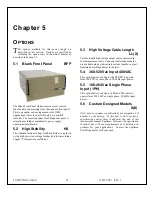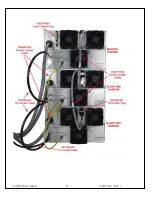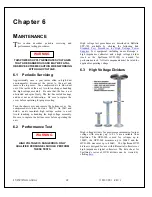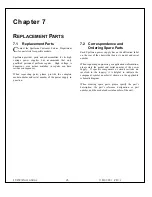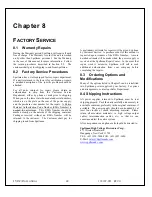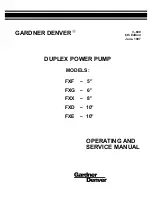
ST/STR/STA MANUAL
9
118107-001 REV J
functionality. HIGH VOLTAGE OFF and HIGH
VOLTAGE ON are controlled by momentary normally
closed, normally open contacts, respectively between pins
14 and 15, and pins 15 and 16. See Figure 3.4 for
recommended interface.
EXTERNAL INHIBIT:
The External inhibit allows the
user to inhibit the power supply output without putting the
power supply into the HIGH VOLTAGE OFF mode.
This circuit can be used to generate fast slewing output
waveforms or control high voltage generation as in Laser
and Capacitor discharge applications. The maximum
inhibit rate should not exceed 5Hz. Consult factory for
higher repetition rates or high pulse load applications.
See Figure 3.5 for the recommended interface circuit.
WARNING
IT IS EXTREMELY DANGEROUS TO USE THE
EXTERNAL INHIBIT TO STOP HIGH VOLTAGE
GENERATION FOR THE PURPOSE OF
SERVICING OR APPROACHING ANY AREA OF
THE LOAD CONSIDERED UNSAFE DURING
HIGH VOLTAGE OPERATION
EXTERNAL INTERLOCK:
The
External
Interlock
connections are provided on the rear panel interface
connecter, pin 3 and pin 4, intended for use in the
connection to a customer provided and implemented
external safety switch. The unit will not operate unless
the interlock circuit is closed. If the interlock is not being
used (use is highly recommended), a jumper must be
installed. During high voltage operation, opening the
External Interlock will cause the unit to revert to the
HIGH VOLTAGE OFF mode. Subsequent closing of the
interlock circuit will NOT return the unit to HIGH
VOLTAGE ON mode; this must be accomplished by
depressing the HIGH VOLTAGE ON switch. See Figure
3.6 for the recommended interface circuit.
ARC DETECT / ARC QUENCH /ARC COUNT:
The
ARC Intervention Circuitry senses dynamic arcing or
discharge conditions present at the output load with a
wide bandwidth current transformer coupled to the return
side of the high voltage multiplier.
The instant an arc is detected the generation of high
voltage is electronically inhibited for 200mS; this is called
the ARC Quench time period. After the 200mS period,
the discharged HV output (level dependent upon arc
impedance, arc duration, etc) is ramped back up to the
previous set level. This ramp time is based on the
standard 200mS Slow Start time constant. The ARC
indicator on the front panel will illuminate for
approximately 500mS after each arc has occurred. The
HV INHIBIT indicator will also illuminate for 500mS
indicating that the output is being inhibited (ARC
Quench).
The factory default setting of the Arc Intervention
circuitry is such that if four arcs occur in a ten second
time period the unit will shut down into the POWER
DOWN mode displaying an “ARC Fault”. ARC
parameters can be modified by using the digital interface
and provided GUI but changing these settings can have
serious consequences.
NOTE: Making changes to the ARC Intervention
Circuitry along with excessive arcing of the power supply
can thermally overheat and damage the internal short
circuit limiting assembly. Damage to the power supplies
internal short circuit limiting assembly is consider misuse
of the unit and repairs will not be covered under the
warranty. The ARC Intervention Circuitry is incorporated
and configured to protect the power supply from
excessive arcing, make changes to this circuitry at your
own responsibility and risk.
REMOTE HIGH VOLTAGE ON & REMOTE HIGH
VOLTAGE OFF:
Signals are provided for remote
monitoring of the HIGH VOLTAGE ON and HIGH
VOLTAGE OFF status. See Figure 3.7 for recommended
interface.
3.3 Digital Interface (RS-
232/Ethernet)
The ST features standard RS-232 and Ethernet digital
interface capability. Please see Appendix A for complete
details on functionality and operation.
3.4 Reversible Polarity (1-10kV
Units Only) ST/STR Only
1 to 10kV units are inherently reversible by design but
still require a polarity selection to be made at time of
order. These units are air insulated and a simple wiring
change made in the high voltage multiplier section can
convert a positive polarity unit to a negative polarity unit,
or vice versa.
3.5 Multiple Chassis Systems
–
ST Only
Additional ST chassis can be connected in parallel to
achieve multiple 12kW increments of power to above and
beyond 100kW’s in a factory configured Master/Slave
arrangement. The Master unit retains its full feature front
panel while the Slave unit(s) have a Blank Front panel.
From an interfacing and functionality standpoint the
multiple chassis system behaves effectively like a single
chassis higher power unit. This technique provides
commonality of physically manageable hardware units
and possibility redundancy further enhancing system
uptime and reliability.

























